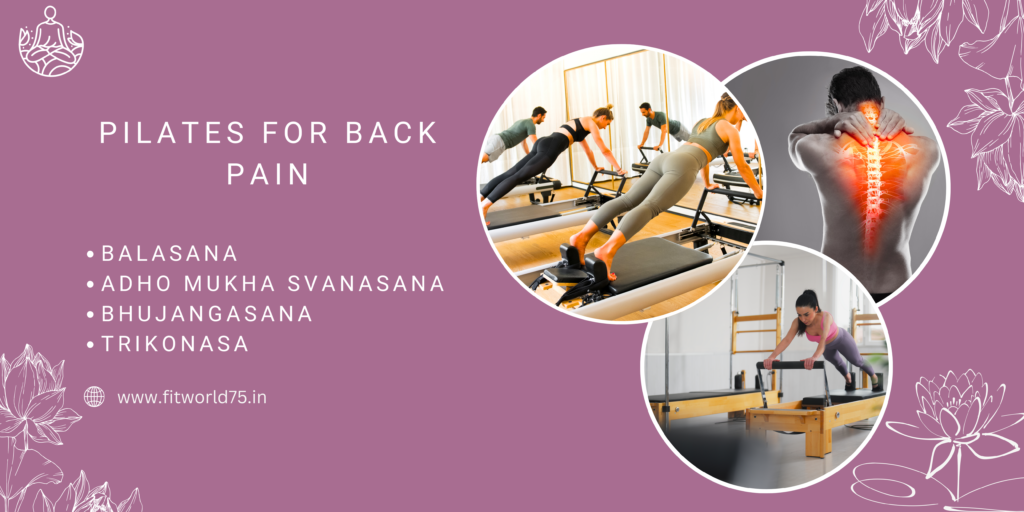The Growing Concern of Back Pain
There are millions of individuals all around the world who suffer from back pain, which is a common condition. Finding relief from back pain is a primary goal for many people, regardless of whether the discomfort is the result of engaging in a sedentary lifestyle, having bad posture, or having had an accident. In recent years, Pilates and yoga have both acquired popularity as excellent approaches for controlling and reducing back pain, thanks to their respective yoga and Pilates practices. On the other hand, which one is superior? Let’s investigate the advantages of both approaches and figure out which one would be more suited to meet your requirements for managing your back pain.
Pilates: Strengthening the Core
Pilates is an exercise regimen that is low-impact and focused on developing the core muscles. These core muscles include the muscles of the abdomen, lower back, hips, and glutes. Through the targeting of these muscles, Pilates seeks to enhance general stability and posture, which can assist in the alleviation of back pain.
Table of Contents
Individuals who suffer from back discomfort may benefit from Pilates because of its regulated movements and emphasis on correct alignment, which can help them create a stronger core, which in turn provides greater support for the spine. Pilates exercises frequently involve stretching and lengthening the muscles, which can help reduce stress and increase flexibility. In addition, Pilates activities are known to be therapeutic.
The versatility of Pilates is one of the most significant advantages of this exercise. Modifications can be made to the exercises in order to accommodate a variety of fitness levels and particular issues affecting back pain. The fact that Pilates can be conducted with specialist equipment, such as the reformer, or with simply a mat makes it accessible to a broad variety of people regardless of their physical abilities.
Yoga: Enhancing Flexibility and Mind-Body Connection
In order to improve one’s general health and well-being, the ancient practice of yoga, which originated in India, incorporates a variety of breathing exercises, physical postures, and meditation. Even though yoga does not mainly focus on strengthening the core as Pilates does, it still offers a plethora of advantages that can help reduce back discomfort.

Yoga postures, also known as asanas, are constructed with the intention of enhancing flexibility, enhancing balance, and promoting good alignment of the spine. There are a number of yoga positions that entail carefully stretching and extending the muscles in the back, which can help release tension and lower the severity of back discomfort.
Additionally, yoga places an emphasis on the mind-body connection in addition to the physical advantages it offers. Through the practice of yoga, individuals may learn to manage stress and tension, which are frequently variables that contribute to back pain. This can be accomplished through the practice of mindfulness and deep breathing.
Choosing the Right Practice for Your Back Pain
When it comes to deciding between Pilates and yoga for those who suffer from back pain, there is no solution that is universally applicable. The practice that is most suitable for you is contingent upon a number of criteria, such as your particular ailment, your current level of fitness, and your individual tastes.
If you are looking for a kind of exercise that is more regimented and under your control, Pilates could be a better option for you. Because of its emphasis on core strength and stability, it can provide treatment for back pain in a focused manner. Individuals who suffer from problems such as ruptured discs or muscular imbalances may find that Pilates is very useful to them.
On the other hand, if you are seeking a comprehensive practice that blends mental well-being with physical activity, yoga can be the answer you’ve been waiting for. Yoga, which emphasizes flexibility, balance, and mindfulness, might help ease back discomfort caused by tense muscles, tension, or poor posture.
Both Pilates and yoga should be performed under the supervision of a trained teacher, particularly if you are already experiencing back discomfort or injuries. This is something that should be taken into consideration. A trainer who is knowledgeable about the subject matter may ensure proper form and alignment, which can reduce the risk of further injury and maximize the benefits of the exercise.
Conclusion
Effective management and relief of back pain can be achieved through the practice of Pilates as well as yoga. Unlike Pilates, which focuses on strengthening the core and developing stability, yoga focuses on increasing flexibility and promoting a connection between the mind and the body. In the end, your particular needs and preferences will determine which option is best for you. It is recommended that you get the advice of a competent trainer or a healthcare practitioner in order to have a better understanding of which practice would be more appropriate for your back discomfort. In order to receive the advantages of either Pilates or yoga on your road toward a back that is pain-free, it is important to keep in mind that consistency and perfect form are the keys to success.
Frequently Asked Questions (FAQs)
Which one is better for back pain: Pilates or yoga?
Effective management and relief of back pain can be achieved through the practice of Pilates as well as yoga. Unlike Pilates, which focuses on strengthening the core and developing stability, yoga focuses on increasing flexibility and promoting a connection between the mind and the body. In the end, your particular needs and preferences will determine which option is best for you.
What are the best asanas for back pain relief?
There are yoga asanas that are good for back pain relief: Child’s pose, cat-cow pose, bhujangasana, trikonasana, and much more.

